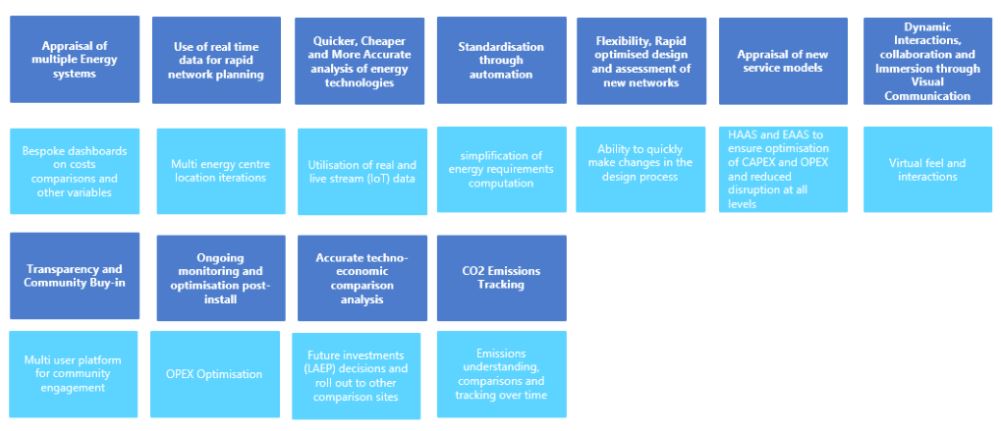Guest blog: Pathways to Net Zero – Smart Energy Digital Twin the Natural Evolution
Data the new oil and Oil bad for the Environment
The UK energy infrastructure was originally built based on large centralised fossil fuel generation. As we transition the energy system to meet legally binding carbon targets, the energy system is becoming more complex with a mixture of centralised and decentralised systems coupled with changing demand patterns and the requirement to introduce new and more complex service models. Critically, transport and domestic use account for nearly two-thirds of final consumption according to government statistics and these sectors are challenging to decarbonise.
The UK Government Target
The UK Government has set a bold net-zero carbon emissions target by 2050. That has made the UK the first G7 country to set a net-zero emissions target. This has created the enabling environment and opportunities to unlock potential resources and investments towards the realisation of the target. Data-driven approach and digital twin solutions will play a fundamental role in accomplishing the target set-to understand the choice of and tracking of the implementation of various efficient energy technologies.
Data-driven and Digital Twin Technology Approach to Decarbonisation
The key to unlocking the decarbonisation challenge and developing innovative solutions to achieving Net Zero carbon emissions lies in making sense of vast quantities of data from a variety of sources:
-
Clients,
-
Consumers,
-
Operators,
-
Industry,
-
Influencing stakeholders,
-
3rd party commercial arrangements,
-
Open-source and public domain sources,
-
Derived data through a combination of the above using computation and analytics methods.
At Buro Happold, we are working with our partners and clients to use a data-driven approach to underpin the development of digital twin solutions to assess different energy infrastructure solutions so that we can provide our clients with the right information and insights at the right time to make the right choices. Our strategy to achieving a data-driven approach revolves around an integrated modular framework based on the elevation of data as a critical asset, development of data and information governance principles and pillars with data security, confidentiality and protection key consideration, application of computation and analytics, and immersive interactions with the data through a visualisation environment. Principally, it is also about integration and interoperability of diverse datasets and of course, the deployment of technology infrastructure either being in the cloud or on-prem geared towards multiple access points and wider reach.
Using Data and information to develop digital replicas of energy infrastructure- enables us to undertake energy network sizing and routing process computation and analytics. This helps us to understand and appraise identified loads and design optimum energy networks based on actual demand, consumer services and evolving technical solutions. For example, we can undertake optimised heat system sizing through real data collection of property usage profiles coupled with building physics algorithms and the use of these profiles to optimise on network CAPEX, consumer energy cost and carbon emissions.
The outputs and computations are used for cross-comparisons to determine policy decisions and intervention so that emission targets can be met through the implementation of appropriate energy systems and technologies for the communities and partners we work with. This also assists our clients in demonstrating the due diligence required in selecting the right solution. We are able to quickly assess the potential of different energy technologies that will suit specific environments to lower emissions, provide efficiencies and flexibility. A typical project example analysed household daily power requirements using different heat system temperatures and established the emissions and techno-economic considerations.
The Key Challenge to Net Zero Emissions
Due to the diversity of datasets and information, data integration and interoperability becomes a challenge. This is because of different organisational cultures and behaviours in data and information modelling and management. However, through data standards, methods and procedures, we can define common protocols for various stakeholders to engage and share data. The benefit is accuracy, consistency, efficiency, and interoperability in the use of data and information.
Value Realisation
The result is the accomplishment of multiple and real-time benefits. Example benefits collation from our projects are highlighted in the dashboard below – it is about data not gut feeling in achieving net-zero emissions:

Authors: Anthony Tuffour – Associate Director: Global Lead Digital Twins and GIS; Phil Proctor – Associate Director: Energy Consultant
Organisation: Buro Happold Ltd
Twitter: Buro Happold (@burohappold) / Twitter
Linkedin: Buro Happold: My Company | LinkedIn
To learn more about the relationship between decarbonisation and digital twins, watch the release of the CDBB’s ‘DT Toolkit’ and techUK’s latest ‘Unlocking Value Across the UK’s Digital Twin Ecosystem’ report

